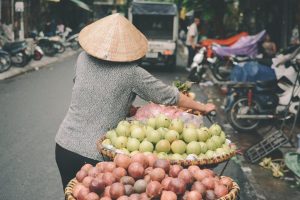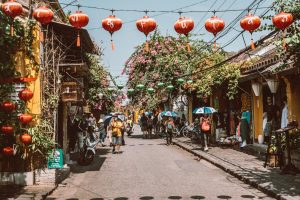Ho Chi Minh City, formerly known as Saigon, is the largest city in Vietnam. The city was the capital of the French protectorate of Cochinchina (1862–1954) and of South Vietnam (1954–75).

In the 19th century, the French took control of the city as part of the French protectorate Conchitina. Beautiful villas, public buildings, boulevards and railways were built, which can still be appreciated today. In addition, Saigon was made the principal collecting point for the export of rice grown in the Mekong River delta.
After a long time of turbulence caused by wars during the 19th-20th centuries, the city eventually returned to rule by Vietnamese people, and was renamed Ho Chi Minh. The city’s architecture is a telltale of its long history. Several of its buildings date back to the time of French colonial rule, making it an historically and culturally fascinating place to visit.
Where is Ho Chi Minh City?

Ho Chi Minh City is located in the southeastern part of Vietnam. It is the largest city in Vietnam with 11mm+ population and never sleeps. The city can be found along the Saigon River to the north of the Mekong Delta, 50 miles from South China Sea.
Why should you visit Ho Chi Minh City?

Ho Chi Minh City is a beautiful and historic city that is open 24/7. The city has plenty of color in every corner. Saigon boasts amazing architecture dating back to the 18th century, bustling city markets, a robust local cuisine and cultural sites.
For architecture and history enthusiasts, as well as foodies, Ho Chi Minh is a must-see city!
Essential facts about Ho Chi Minh City

- Language – Vietnamese and English. Among locals, spoken English is very limited.
- Currency – Vietnamese đồng (VND, ₫) and US Dollars. You can exchange currency in banks and gold/jewelry shops.
- New Restrictions – To enter Vietnam, you need to submit a health declaration form and give your contact details. You will also need an e-visa. The requirements and fees you need to enter Vietnam will depend as well on what passport you carry. For more information, you can check in iVisa.com.
- Modes of Payment – Credit cards are accepted in upscale institutions. In smaller stores, cash is king.
- Electricity – 220V, 50Hz. For sockets, types A and C. You will also need an adaptor. Please bring adaptors and an extension cord especially if you plan on vlogging and taking footage of your travels.
- Climate – Vietnam has a tropical climate. It also has two seasons: wet (rainy) and dry (hot).Therefore, the best time to visit Ho Chi Minh City is from December to March.
How can I go to Ho Chi Minh City in Vietnam?

If you are coming from another country, then your best bet for transportation is by air. You will arrive via Tan Son Nhat International Airport.
From the airport, there are several ways you can go to Ho Chi Minh City. These are the following:
- Taxis – Taxis populate the area around Vietnam’s airport hub. Due to their high population density around the airport area, you can easily grab one after your arrival. Trusted metered taxis, green Mai Linh, and white with red and green, Vinasun Taxi are great options for going to and around Ho Chi Minh City safely.
- Grab and Uber – Compared to taxis, the fees for Grab and Uber are 50-70% cheaper. If you do end up using these apps, please be careful as these apps have caused friction between drivers of taxis and these apps.
- Xe om – A xe om (motorbike) is a local form of transportation. If you have few (and considerably small) belongings and minimal bags, you can take a xe om into the city center.
- Buses – Buses are the cheapest form of transport on the way to Ho Chi Minh City. Bus 109 takes you to the city for 45 minutes. Conversely, Bus 49 is faster and passes by various Ho Chi Minh city hotels. You can ask the ticket vendor at the airport bus stop if you are unsure of which bus to take.
Where can I stay in Ho Chi Minh City?

In Ho Chi Minh City, you can stay in District 1. Ben Thanh Market and Pam Lu Ngao Street are located in District 1. Most travelers flock to District because there are plenty of hostels, dormitories and budget hotels located in District 1. There are also souvenir shops and cheap restaurants in District 1.
An advantage of District 1 is its accessibility. District 1 is a stop for buses to and from the airport and other destinations in Vietnam and Cambodia. The local shuttle from the airport also drives by District 1.
The top budget hotels in the city are the Thien Thu Hotel, Alagon Zen Hotel & Spa, Chill Suites and Maison De Camille Boutique Hotel.
How can I travel around Ho Chi Minh City?
You can travel around Ho Chi Minh City through taxi and bus. For taxis, Vinasun and Mai Linh taxi companies are reliable and trustworthy, according to WikiTravel. Buses are considered the cheapest form of transportation around the city. A third option for transportation around the city is Grab.
A quick guide to Vietnamese etiquette

Before going headfirst into exploring Vietnam, it’s important to learn a bit about local etiquette to avoid embarrassing situations.
Humility, restraint, and modesty are valued in Vietnamese culture. It is advisable not to boast or show off wealth. As Vietnamese culture frowns on public displays of affection, you should also refrain from touching members of the opposite sex. Moreover, when dressing, opt for more modest choices and cover your body. The Vietnamese also greatly value their elders so it is best to give honor and preference to the eldest member of the group.
Meeting and greeting locals
The way you pronounce and control your intonation can change the meaning of the words you say in Vietnamese.
You need to listen carefully to the words when you are trying to learn them. To say Hello, say “Xin Chao” (sin jow). For those who are closer to you, you can greet them with “Chao!” If you are addressing strangers and people who are not close to you, it is advisable to use “Xin Chao” to show respect.
Don’t forget to use the appropriate pronouns as well!
Visiting tourist and religious sites
Vietnam has sites for Buddhism and Hinduism. These sites tend to be very popular so it is important to know how to behave and how to dress appropriately in them. Respect is a must. On your visit, be aware that other people are also here to worship and pay their respects.
Here are some tips:
- Avoid tight-fitting and short attire. For women, your bottom wear/dress should reach at least your knees.
- Take your hats off when you are at a sacred site.
- Do not touch the head of another person; in Vietnam, this is the most sacred spot of their entire body.
- Please do not point your feet or soles toward anyone or any sacred statues, such as Buddha. This is considered very disrespectful.
Dining etiquette
- In Vietnam, it is customary to express your excitement for your meal.
- In Vietnam, elders are given preference. Once the oldest person in your group begins to eat, then it is safe to start eating.
- If you pick up your food with your chopsticks, put it on your plate first before popping it in your mouth.
- Do not dip your chopsticks into the shared bowl.
- Avoid “mining” for specific bits of food in your meal. This indicates that you are a picky eater.
- Please do not play with your chopsticks.
- Leave a clean plate, as this is seen to be a compliment..
- Do not leave the dining area too early after you have finished eating. It is considered rude.
What to wear
- Loose and breathable clothing that covers down to your knees (especially if you will enter a sacred and religious area).
- A light jacket
- Light fabrics (it can be hot)
- A swimsuit if you intend to go swimming
- A sarong
- A pair of reliable sandals and sneakers for heavy hiking
- Raincoat (in case it rains)
Vietnam is a tropical country, so it is generally recommended to bring clothes made of breathable and light fabric. To cover up at the beach, you may like to wear a sarong. If you do intend to go hiking, comfortable and durable footwear sneakers) are a must. If you visit during monsoon season, keeping a raincoat around is very handy.
Things You Should Do in Ho Chi Minh City

With plenty of amazing sights and historical places, Ho Chi Minh City is a memorable city. Here’s a list of activities you can do in the city and note in your excel trip planner!
1)Visit Ho Chi Minh’s Mausoleum and Museum

This museum is dedicated to Ho Chi Minh, who is a late Vietnamese leader. In addition, the museum covers the struggle of Vietnam for autonomy and independence. This site is a must go-to as it provides you a better understanding of the struggles the Vietnamese people went through. The museum houses a collection of artifacts, miniatures and various gifts. Descriptions for the displays are written in French, English and Vietnamese. You can opt to get a guided tour.
2)Stroll around Ho Chi Minh

Aside from its historic significance and architecture, the city has a bustling nightlife and shopping hub.
3)Go on a walking tour of Chinatown

Also known as Cholon, this quarter of the city lies on the west bank of the Mekong River. It is also deemed the largest Chinatown in the world. This is a famous tourist spot which has also seen historical events.
4)Visit Cu Chi Tunnels

These tunnels were dug during the 1940s during Vietnam’s war of independence against French forces. The tunnels were dug by hand and by a short distance at a time. During the peak of the Vietnam War, the tunnels linked Viet Cong support bases over a distance of some 250 kilometers.
5)See the Presidential Palace (now known as the Reunification Hall)
The Reunification Hall is home and workplace to the President of Vietnam. It closes at 12pm. Renowned architect Ngô Viết Thụ designed this. This building has 3 floors and was formerly known as Norodom Palace.
6)Embark on a full day Tour to the Mekong Delta

The Mekong Delta is a vast maze of swamps and rivers located to the west of Saigon. Here, you will use boats to navigate around. This area had significant and strategic importance during the Vietnam war.
7) Tour the Cai Be floating market

The Cai Be floating market is a wholesale market where you can buy directly from the local fruit and vegetable farmers. It is open for 24 hours.
8) Take a local cooking class

Vietnamese cuisine is delicious and features noodles, rice paper and bread. With its delectable tastes and hints of umami from the sauces and meat, it is a memorable cuisine. To learn how to make Vietnamese favorite dishes, you can take your local cooking class, and even doing a street food tour
9) View the sky from the Saigon Skydeck in Bitexco Financial Tower

The Saigon Skydeck is located on the 49th floor of Bitexco Financial Tower. It is made of glass and features scenic views. From this place, you can see the city skyline.
Storylines is an inclusive residential luxury cruise ship with a community of global citizens who want to make the most out of amazing and memorable cultural immersion experiences. Travel around the world! Happy traveling!






